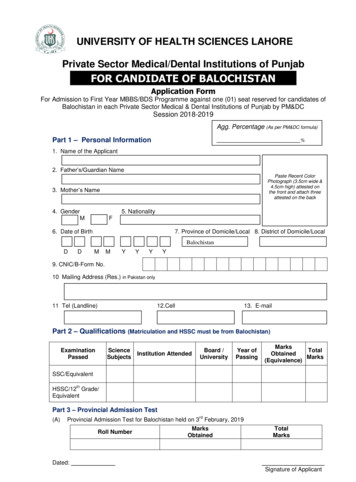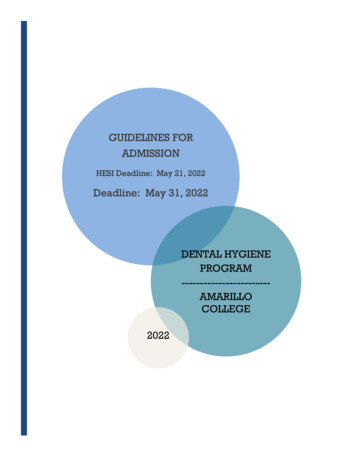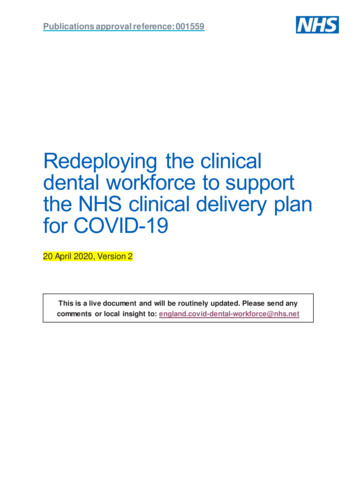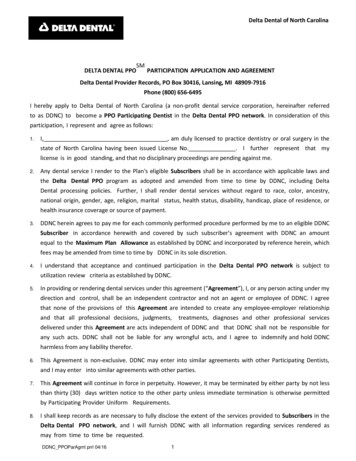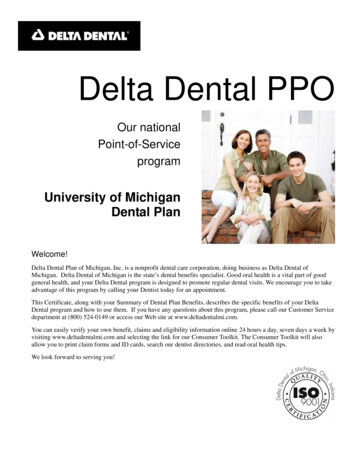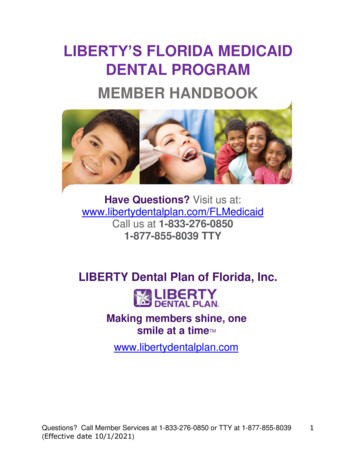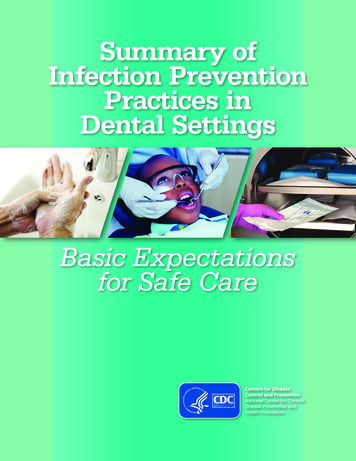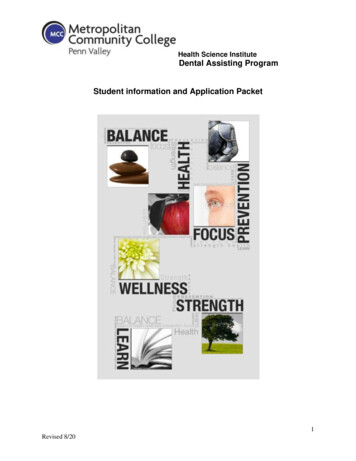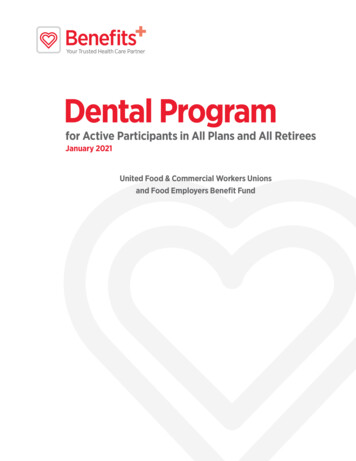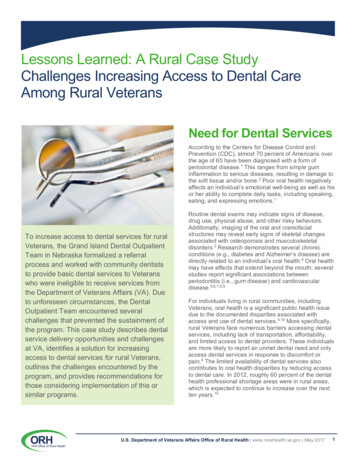
Transcription
Lessons Learned: A Rural Case StudyChallenges Increasing Access to Dental CareAmong Rural VeteransNeed for Dental ServicesAccording to the Centers for Disease Control andPrevention (CDC), almost 70 percent of Americans overthe age of 65 have been diagnosed with a form ofperiodontal disease.1 This ranges from simple guminflammation to serious diseases, resulting in damage tothe soft tissue and/or bone.2 Poor oral health negativelyaffects an individual’s emotional well-being as well as hisor her ability to complete daily tasks, including speaking,eating, and expressing emotions.1To increase access to dental services for ruralVeterans, the Grand Island Dental OutpatientTeam in Nebraska formalized a referralprocess and worked with community dentiststo provide basic dental services to Veteranswho were ineligible to receive services fromthe Department of Veterans Affairs (VA). Dueto unforeseen circumstances, the DentalOutpatient Team encountered severalchallenges that prevented the sustainment ofthe program. This case study describes dentalservice delivery opportunities and challengesat VA, identifies a solution for increasingaccess to dental services for rural Veterans,outlines the challenges encountered by theprogram, and provides recommendations forthose considering implementation of this orsimilar programs.Routine dental exams may indicate signs of disease,drug use, physical abuse, and other risky behaviors.Additionally, imaging of the oral and craniofacialstructures may reveal early signs of skeletal changesassociated with osteoporosis and musculoskeletaldisorders.3 Research demonstrates several chronicconditions (e.g., diabetes and Alzheimer’s disease) aredirectly related to an individual’s oral health.4 Oral healthmay have effects that extend beyond the mouth; severalstudies report significant associations betweenperiodontitis (i.e., gum disease) and cardiovasculardisease.5,6,7,8,9For individuals living in rural communities, includingVeterans, oral health is a significant public health issuedue to the documented disparities associated withaccess and use of dental services.4,10 More specifically,rural Veterans face numerous barriers accessing dentalservices, including lack of transportation, affordability,and limited access to dental providers. These individualsare more likely to report an unmet dental need and onlyaccess dental services in response to discomfort orpain.4 The limited availability of dental services alsocontributes to oral health disparities by reducing accessto dental care. In 2012, roughly 60 percent of the dentalhealth professional shortage areas were in rural areas,which is expected to continue to increase over the nextten years.10U.S. Department of Veterans Affairs Office of Rural Health www.ruralhealth.va.gov May 20171
Lessons Learned: Rural Case Study Challenges Increasing Access to Dental Care Among VeteransVeterans’ Access toDental ServicesBased on the VA Benefits Package, VA provides limiteddental services to eligible Veterans. A Veteran mustmeet at least one of the following criteria to be eligiblefor dental services: Have a service-connected compensable dentaldisability or condition; Be a former prisoner of war; Have a 100 percent service-connected disability; Have a service-connected non-compensabledental condition or disability resulting fromcombat wounds or service; Have a dental condition that aggravates or isassociated with a service-connected condition; Be actively engaged in a 38 USC Chapter 31vocational rehabilitation program; Be receiving VA care or scheduled for inpatientcare and require dental care for a conditioncomplicating a medical condition currently undertreatment; or Be an enrolled Veteran who may be homelessand receiving care under the Veterans HealthAdministration Directive 2007-039.A Proposed Solution:Dental Outpatient TeamAt the Grand Island VA Medical Center (VAMC), theDental Outpatient Team recognized an opportunity toincrease Veterans’ access to needed dental services. In2010, the team established a volunteer-run dentalreferral program to refer Veterans to dental serviceswithin the VA health care system or to local communityproviders. The Dental Outpatient Team worked with localdental clinics (e.g., Dental Day, Sharing Clinics, DentureClinic, and Mission of Mercy) and the University ofNebraska Medical Center College of Dentistry (UNMC),located in Lincoln, NE, to provide Veterans who areineligible for VA dental services with access to dentalcleanings and other minor procedures. The programprovided an estimated 25 Veterans with dental servicesthrough a Saturday clinic and two evening clinics. Forclinics held at UNMC, the team arranged for volunteerstaff to provide transportation to and from appointments,addressing potential transportation barriers.Before implementing the program, the team conductedan analysis to develop a deeper understanding of thelocal Veteran population and their dental needs. Throughthis analysis, the team determined that 95 percent ofVeterans who utilized the Grand Island VAMC wereineligible for VA dental services and VA clinicians madevery limited referrals to dental services. Many of theseVeterans faced transportation and financial barriers inaccessing needed dental care. Through this analysis,the program team developed a more targeted programto address the dental needs of local Veterans.After the needs analysis was completed, the DentalOutpatient Team established an interdisciplinary team,which included a physician, dentist, social worker, nurse,administrative staff, and community stakeholders. TheDental Outpatient Team began to create awareness ofthe program among VA providers and clinicians. Thedental referral program operated for 18 months andinitially demonstrated evidence of a rural promisingpractice based on six criteria defined by the VA’s Officeof Rural Health (ORH). These criteria include 1)increased access, 2) evidence of clinical impact, 3)customer satisfaction, 4) return on investment, 5)operational feasibility, and 6) strong partnerships and/orworking relationships. Specific areas of strength arehighlighted below.Consistent Referral Process: To improve operationalfeasibility and ensure consistency, the program teamdeveloped a standardized consult template in VA’smedical records system to refer Veterans to the DentalOutpatient Team. Then, the team would determinewhether a Veteran was eligible for VA dental services. Ifa Veteran was ineligible for VA dental care, the programteam worked with local dental clinics to provide Veteranswith needed dental services. By increasing access todental services, the Dental Outpatient Teamdemonstrated clinical impact by reducing infectionsrelated to tooth decay and further complicationsassociated with poor oral health.Creating Awareness of Veterans’ Needs: The DentalOutpatient Team conducted an end-to-end review of thedental referral process to develop a more systematicapproach to referring Veterans to dental services. TheDental Outpatient Team developed and disseminated astandardized referral template to providers; the referralthen triggered a series of follow-up actions by theprogram coordinator. This created consistent awarenessamong providers about availability of dental servicesthrough both VA and non-VA providers as well as aconsistent referral process.U.S. Department of Veterans Affairs Office of Rural Health www.ruralhealth.va.gov May 20172
Lessons Learned: Rural Case Study Challenges Increasing Access to Dental Care Among VeteransLeveraging Community Providers: The Dental OutpatientTeam established unique partnerships with local dentalclinics and UNMC’s College of Dentistry to provideVeterans with needed dental treatment. The programteam established a streamlined process for thepreparation of relevant documents to ensure thatVeterans’ medical documentation was provided to thecommunity dentist. During the Saturday and eveningdental clinics, dental students from UNMC treatedVeterans and staff volunteers provided supportpreparing for appointments and cleaning betweenappointments. The Dental Outpatient Team worked witha local church and volunteers to provide transportation toand from Grand Island to Lincoln (approximately 90miles each way). The community clinics demonstratedan increase in access to dental services and had apositive clinical impact for Veterans.Lessons Learned fromthe Grand Island DentalOutpatient TeamAs other facilities consider implementing similar dentalreferral programs, they may find the following lessonslearned from the Grand Island Dental Outpatient Teamuseful:Formal Relationships with Community Partners: TheDental Outpatient Team partnered with communitydentists and the local dentistry college and theserelationships were largely established through theprogram champion, who was a physician in this case.After the program champion left in 2011, the DentalOutpatient Team was unable to continue to leverage thecommunity partnerships to provide dental services toVeterans. The facility staff tried to establish newpartnerships with community clinics and local dentists;however, they were unable to get the necessary support. Facilities need to have strong partnerships withlocal dental clinics and/or affiliations with dentalcolleges with minimal costs. Formalized agreements or partnerships arecritical to ensure that the program will continueregardless of potential staff turnover.Dedicated Program Staff: The Dental Outpatient Teamrelied on VA staff and other external volunteers todonate their time to assist with the weekend and eveningclinics, and to coordinate medical documentation. Theprogram team estimated that staff spent roughly 200hours to implement and sustain the program. Staffturnover and the reliance on volunteers limited theoperational feasibility of the program. A dedicated multidisciplinary team wouldmitigate the risks associated with staff turnoverand improve the sustainment of the overallprogram. The multidisciplinary team shouldinclude stakeholders from primary care, dentalservices, facility leadership, and communitystakeholders. A Program Coordinator should also be assignedto the program, reducing the reliance on staffvolunteers. The Program Coordinator should beresponsible for coordinating Veterans’appointments, medical documentation, and datacollection.Formal and Consistent Processes and Procedures: TheDental Outpatient Team faced challenges associatedwith a limited or lack of processes and procedures aswell as a non-regular dental clinic schedule. Formal and consistent processes andprocedures regarding regularly scheduled (e.g.,once a month) clinic for Veterans based ondemand will improve the program’s operationalfeasibility. A more formalized structure for the evening andSaturday clinics will increase access to dentalservices and reduce potential risks associatedwith staff turnover.Rigorous Data Collection: The program staff did notcollect any metrics related to Veterans health outcomesand customer satisfaction. The limited operations andsmall number of participants contributed to the ability ofthe program staff to conduct any formal analysis todetermine the potential return on investment. Health outcomes should be collected todetermine clinical impact, including time sincethe last visit to the dentist, preventive servicesreceived during the past two years, percentageincrease in patient served, and other healthoutcome measures. Stakeholder satisfaction surveys should bedesigned to determine impact on Veterans andcommunity dentists to allow for continuousrefinement of the program. Through robust data collection, program staffshould allow for critical analysis to determinepotential return on investment further supportingprogram needs, including cost avoidancesrelated to poor oral health and complicationassociated with tooth decay and infections.U.S. Department of Veterans Affairs Office of Rural Health www.ruralhealth.va.gov May 20173
Lessons Learned: Rural Case Study Challenges Increasing Access to Dental Care Among VeteransConclusion and NextStepsMany rural Veterans do not have dental coverage orface numerous barriers to receiving dental care. Referralprograms like this one can increase patient access todental services. The components of this program do notrequire special equipment, resources, or training andcan be replicated at rural clinics throughout the VAhealth care system. This program demonstrates theability to improve access to dental care and improveclinical outcomes for Veterans.Facilities considering establishing or implementing adental referral program should formalize communitypartnerships, identify dedicated staff, documentprocesses and procedures, and collect data. The DentalOutpatient Team established a unique program forVeterans, but due to unforeseen challenges was unableto sustain the program. This provides other facilities withan opportunity to understand these potential challengesand strengthen the program prior to implementation atadditional sites.Additional InformationThe VHA Office of Rural Health (ORH) implements atargeted, solution-driven approach to increase access tocare for the three million Veterans living in ruralcommunities who rely on VA for health care. As VA’slead advocate for rural Veterans, ORH works to see thatAmerica’s Veterans thrive in rural communities. Toaccomplish this, ORH leverages its resources to study,innovate, and spread enterprise-wide initiatives throughpartnerships.By collaborating with other VA program offices, federalpartners, state partners, and rural communities, ORHoptimizes the use of available and emergingtechnologies, establishes new access points to care, andemploys strategies to increase health care options for allrural Veterans.UNMC Students Give a Veteran aNew Reason to SmileOriginally published April 8, 2011By Catherine Crane, 1011 News, NebraskaPlenty of people fear this chair, but not Roger Minx."I have spent a lot of time in the dental chair frombeing a navy diver," said Minx. "These are the bestchairs I've sat in."Roger is a navy Veteran. Thursday night he's apatient at the University of Nebraska MedicalCenter’s free dental clinic for Grand Island Veterans."My teeth are getting better for sure, thanks to theUniversity of Nebraska," said Minx."They've served us and now we can serve them,"said Laura Chambers a UNMC Nursing student.This is Roger's second trip to the clinic."I was on liquids when I came down last time, andthey did what I wanted them to do here," said Minx."They didn't just pull a tooth and send me out thedoor, they fixed my front tooth."He says the reward was sweet."The first thing I did was I took my son and we wentand had a steak," said Minx.Roger says the experience has changed his life, andthe dental student he was paired with, agrees."It does for us too, for us to be able to help out andvolunteer our time," said Kyle Beulke, a UNMCDentistry student."There are going to be some great dentists comingout of this school," said Minx. "They have thecompassion and kindness in their hearts. I don't thinkI've ever been treated this good."Roger says he's one happy Veteran.U.S. Department of Veterans Affairs Office of Rural Health www.ruralhealth.va.gov May 20174
Lessons Learned: Rural Case Study Challenges Increasing Access to Dental Care Among VeteransPoint of ContactJanelle K. Brock, MSW, LICSWLicensed Independent Clinical Social WorkerVA-Nebraska Western Iowa Healthcare System1.866.580.1810 X9-2059Janelle.brock@va.govReferencesCenters for Disease Control and Prevention. (2016).Oral Health. Retrieved nal Institute of Dental and CraniofacialResearch (2013). Periodontal (gum) disease:Causes, symptoms, and treatments. NIH PublicationNo. 13-1142. Retrieved mDiseases/PeriodontalGumDisease.htmU.S. Department of Health and Human Services.(2000). Oral health in America: A report of theSurgeon General. Rockville, MD: U.S. Department ofHealth and Human Services, National Institute ofDental and Craniofacial Research, National Instituteof Health.Singer Cohen, R. & Stitzel, J. (2015). Improvingdental care access in rural America. Retrieved -access-in-rural-americaDeStefano, F., Anda, R.F., Kahn, H.S., Williamson,D.F., & Russell, C.M. (1993). Dental disease andrisk of coronary heart disease and mortality. BMJ,306, 688–691.Beck, J., Garcia, R., Heiss, G., Vokonas, P.S., &Offenbacher, S. (1996). Periodontal disease andcardiovascular disease. Journal of Periodontology,67, 1123–1137.Mattila, K.J., Nieminen, M.S., Valtonen, V.V., Rasi,V.P., Kesaniemi, Y.A., Syrjala, S.L., Jungell,M .Jokinen, M.J. (1989). Association betweendental health and acute myocardial infarction, BMJ,298, 779–781.Geerts, S.O., Legrand, V., Charpentier, J., Albert, A.,& Rompen, E.H. (2004). Further evidence of theassociation between periodontal conditions andcoronary artery disease. Journal of Periodontology,75, 1274–1280.Morrison, H.I., Ellison, L.F., & Taylor, G.W. (1999).Periodontal disease and risk of fatal coronary heartand cerebrovascular diseases. Journal ofCardiovascular Risk, 6, 7–11.Haley, J., Kenney, G., Shartzer, A., & Anderson, N.(2015). Honoring those who served: Closingcoverage and access gaps for veterans. HealthAffairs. Retrieved s-for-veterans/Rural Health Information Hub. (nd). Oral health inrural communities. Retrieved althU.S. Department of Veterans Affairs. (2014). Dentalbenefits for veterans. Retrieved lications/IB10442 dental benefits for veterans 2 14.pdfU.S. Department of Veterans Affairs Office of Rural Health www.ruralhealth.va.gov May 20175
and limited access to dental providers. These individuals are more likely to report an unmet dental need and only access dental services in response to discomfort or pain.4 The limited availability of dental services also contributes to oral health disparities by reducing access to dental care. In 2012, roughly 60 percent of the dental


